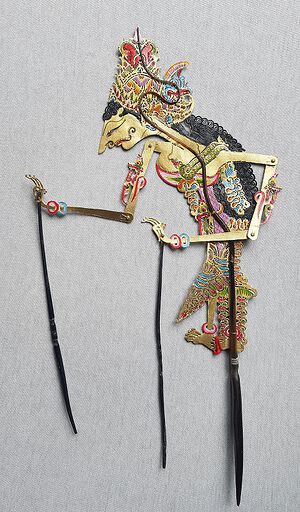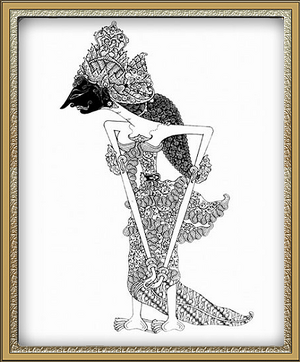Rukmini - (Wayang Kulit)
| Title | Rukmini - (Dewi) - Mahabharata |
|---|---|
| Other names | |
| Size | 37 cm |
| Personal data | Dewi Rukmini is the eldest daughter of Prabu Bismaka / Arya Prabu Rukma, the king of Kumbina country with his consort Dewi Rumbini. Dewi Rukmini has a younger brother named Arya Rukmana and another maternal sibling named Dewi Rarasati/Dewi Larasati, daughter of Arya Prabu Rukma and Ken Sagupi, a swarawati of the Mandura palace. Dewi Rukmini married her cousin, Narayana, son of Prabu Basudewa, the king of Mandura with consort Dewi Mahendra/Maerah (Java). |
| Appearance | Dewi Rukmini's character is: full of compassion, patience, loyalty and jatmika (always with good manners). |
| Collection | Private collection |
Rukmini - (Dewi) - Mahabharata
In many Puranic literature, Rukmini is believed to be an incarnation of Goddess Lakshmi. It is said that Lord Krishna was an embodiment of Lord Vishnu. And Lakshmi being the inseparable wife of Lord Vishnu took birth as Rukmini in her next life. She was born in the house of Bhismaka, king of Vidharbha. Rukmini is the incarnation of Goddess Lakshmi. Rukmini is the first and most prominent queen of Krishna. Rukmini is also considered an avatar of Lakshmi, the Goddess of fortune.
After Narayana managed to seize the country of Dwarawati from the power of King Narasinga, and crowned himself as the king of Dwarawati with the title of King Sri Bathara Krishna, Dewi Rukmini was appointed as his consort. From that marriage she got 3 (three) sons each named: Saranadewa (giant), Partadewa and Dewi Titisari/Sitisari, who after growing up became the wife of Bambang Irawan, Arjuna's son with Dewi Ulupi/Palupi.
After King Krishna's death, Dewi Rukmini and his other wives plunged into the Pancaka (cremation fire) and followed her husband back to Nirvana. Dewi Rukmini died in old age.
Source: History of Wayang Purwa - Hardjowirogo - PN Balai Pustaka - 1982


